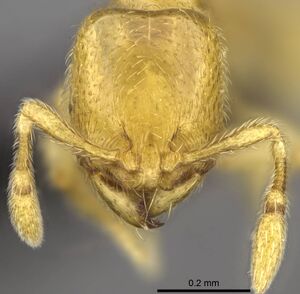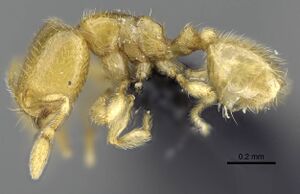Carebara betsi
| Carebara betsi | |
|---|---|

| |
| Scientific classification | |
| Kingdom: | Animalia |
| Phylum: | Arthropoda |
| Class: | Insecta |
| Order: | Hymenoptera |
| Family: | Formicidae |
| Subfamily: | Myrmicinae |
| Tribe: | Crematogastrini |
| Genus: | Carebara |
| Species: | C. betsi |
| Binomial name | |
| Carebara betsi Azorsa & Fisher, 2018 | |
Carebara betsi is known only from the center of Madagascar, in montane rainforest with an elevation of 1410 m, and was collected in sifted litter using Winkler traps on a 50 sample transect. The microhabitats of this species are leaf mold and rotten wood.
Identification
Azorsa and Fisher (2018) - Antennae ten-segmented. Major: Head subrectangular, longer than wide, lateral margins straight and parallel, dorsal face of head longitudinally rugose-rugulose, rugae extend from frontal lobes and posterior margin of supraclypeal area to the posterior margin of the head; combined outline of dorsal surface of peduncle and anterior face of node flat, posterior face node vertical and nearly straight; dorsum of propodeum flat and declining posteriorly; gaster with abundant subdecumbent hairs. Minor: Head longer than wide, weakly subrectangular, posterior margin of head medially concave; combined outline of dorsal surface of peduncle and anterior face of node straight, posterior face vertical and slightly convex; dorsum of propodeum flat and declining posteriorly; gaster with abundant subdecumbent hairs. There are no intermediate castes.
Carebara betsi is endemic to the montane rainforest on the high plateau of Madagascar and can be easily separated from the other species by the following combination of characters: combined outline of dorsal surface of peduncle and anterior face of node flat, and hairs on the gaster abundant and subdecumbent. Also major workers present well-marked longitudinal and parallel rugae. Other seven species are present in this area: Carebara grandidieri, Carebara hainteny, Carebara jajoby, Carebara kabosy, Carebara mahafaly, Carebara nosindambo, and Carebara omasi, which can be differentiated from C. betsi by the combination of characters mentioned above.
Keys including this Species
Distribution
Latitudinal Distribution Pattern
Latitudinal Range: -18.22528° to -18.47333°.
| North Temperate |
North Subtropical |
Tropical | South Subtropical |
South Temperate |
- Source: AntMaps
Distribution based on Regional Taxon Lists
Malagasy Region: Madagascar (type locality).
Distribution based on AntMaps
Distribution based on AntWeb specimens
Check data from AntWeb
Countries Occupied
| Number of countries occupied by this species based on AntWiki Regional Taxon Lists. In general, fewer countries occupied indicates a narrower range, while more countries indicates a more widespread species. |

|
Estimated Abundance
| Relative abundance based on number of AntMaps records per species (this species within the purple bar). Fewer records (to the left) indicates a less abundant/encountered species while more records (to the right) indicates more abundant/encountered species. |

|
Biology
Castes
Worker
Images from AntWeb
   
| |
| Paratype of Carebara betsi. Worker. Specimen code casent0479432. Photographer Frank Azorsa, uploaded by California Academy of Sciences. | Owned by CAS, San Francisco, CA, USA. |
Nomenclature
The following information is derived from Barry Bolton's Online Catalogue of the Ants of the World.
- betsi. Carebara betsi Azorsa & Fisher, 2018: 42, figs. 34, 68 (s.w.) MADAGASCAR.
- Type-material: holotype major worker, 5 paratype major workers, 26 paratype minor workers.
- Type-locality: holotype Madagascar: Antananarivo, Rés. Spéc. d’Ambohitantely, Forêt d’Ambohitantely, 20.9 km. 72° NE Ankazobe, -18.22528, 47.28683, 1410 m., 17-22.iv.2001, BLF03694, montane rainforest (Fisher, Griswold, et al.); paratypes with same data.
- Type-depositories: CASC (holotype); BMNH, CASC, MCZC, MHNG, NHMB (paratypes).
- Distribution: Madagascar.
Unless otherwise noted the text for the remainder of this section is reported from the publication that includes the original description.
Description
Worker
Major. (n=7): HL 0.51–0.63 (0.58); HW 0.40–0.50 (0.45); SL 0.20–0.27 (0.24); ML 0.09–0.13 (0.10); EL 0.02; EM 0.14– 0.18 (0.17); HD 0.28–0.38 (0.28); WL 0.44–0.57 (0.52); PSL 0.05–0.08 (0.07); PW 0.27–0.33 (0.33); MFL 0.24–0.32 (0.32); MFW 0.07–0.09 (0.08); MTL 0.17–0.25 (0.21); PTL 0.19–0.22 (0.21); PNL 0.08–0.09 (0.09); PTH 0.15–0.19 (0.17); PTW 0.13–0.15 (0.15); PPL 0.11–0.16 (0.13); PPNL 0.10–0.13 (0.11); PPH 0.12–0.15 (0.13); PPW 0.17–0.20 (0.19); GL 0.43–0.58 (0.46); GW 0.35–0.42 (0.39); CI 75–79 (78); MI 15–22 (17); SI 37–44 (41); MLI 60–71 (71), PPLI 55–76 (62); PPI 121–133 (127); PSI 11–19 (16).
Head longer than wide (CI 75–79), in full-face view nearly subrectangular, about 1.4 times longer than wide. Posterior margin of head medially concave, posterolateral corners rounded, lateral margins straight. Mandible with five teeth. Anterior margin of clypeus slightly concave, nearly straight, and laterally convex. Antennae with ten segments. Scapes short (HL 0.51–0.63, SL 0.20–0.27, SI 37–44). Eyes present, consisting of two ommatidia (EL 0.02). Ocelli absent (weakly present in some major workers). Supraclypeal area well defined and triangular.
In profile view, promesonotum high and convex, metanotal groove deeply impressed. Propodeum about 1.6 times higher than long, dorsal face of propodeum flat, declining posteriorly, propodeum armed, posterodorsal corners each armed with a small triangular tooth, anterodorsal corners angulate, declivity of propodeum concave with thin lateral laminae. Propodeal lobes short and convex. Propodeal spiracle rounded and situated above mid-height of sclerite, and beyond mid-length of sclerite, by about the diameter of the spiracle; distance from propodeal spiracle to posterodorsal corner of propodeum almost three times the diameter of the spiracle (PSL 0.05–0.08), and distance to declivity almost the same as the diameter of the spiracle. In dorsal view, promesonotum about as long as wide, anterior margin and sides rounded; sides of propodeum weakly convex.
Petiole slightly longer than high (PTH 0.15–0.19, PTL 0.19–0.22) with short peduncle, ventral face medially convex. Combined outline of dorsal surface of peduncle and anterior face of node flat, posterior face of node vertical and slightly concave, dorsum weakly rounded, anterodorsal corner convex, and posterodorsal corner weakly rounded. Petiolar node slightly narrowed at its dorsum. Subpetiolar process small, weakly triangular, and shorter than the diameter of the propodeal spiracle, at about half the diameter of the spirale. Postpetiolar node rounded and lower than petiolar node. In dorsal view, postpetiolar node wider than petiolar node (PPW 0.17–0.20, PTW 0.13–0.15), petiolar node wider than long (PTW 0.13–0.15, PNL 0.08–0.09), anterior and posterior margins of petiole and postpetiole straight, sides rounded in petiole and strongly convex in postpetiole.
Dorsal surface of mandibles, lower median portion of clypeus and supraclypeal area smooth and shiny, with scattered piligerous punctae on head and mandibles. Head with longitudinal, well-defined rugae, which extend from propodeal lobes and posterior margin of supraclypeal area to posterior margin of head, with a few, weak rugulae on upper median portion of clypeus. In profile, posterolateral portion of cephalic dorsum usually smooth and shiny, sometimes with short longitudinal rugulations. Sides of pronotum smooth and shiny, while mesopleuron, metapleuron, petiole and ventral face of postpetiole are areolate. In dorsal view, promesonotum smooth and shiny medially, as well as postpetiole and gaster, finely areolate on propodeum, petiole and near anterior and posterior margins of promesonotum.
Lateral margins and posterior margin of head with short suberect hairs, scapes with appressed hairs, and outer margin of mandible with decumbent hairs. Mesosoma with short and long suberect hairs. Petiole and postpetiole with subdecumbent hairs, and longer suberect hairs, gaster with abundant subdecumbent hairs. Tibia with abundant subdecumbent and decumbent hairs. Color yellowish ferruginous.
Minor. (n=7): HL 0.36–0.39; HW 0.29– 0.33; SL 0.22–0.23; ML 0.09–0.11; EL 0.01; EM 0.11–0.12; HD 0.22–0.25; WL 0.38– 0.42; PSL 0.03–0.04; PW 0.18–0.21; MFL 0.22–0.25; MFW 0.05–0.07; MTL 0.14– 0.19; PTL 0.13–0.14; PNL 0.06–0.07; PTH 0.11–0.12; PTW 0.08–0.10; PPL 0.08–0.09; PPNL 0.07–0.09; PPH 0.08–0.09; PPW 0.12–0.13; GL 0.29–0.36; GW 0.24–0.28; CI 81–85; MI 24–28; SI 58–64, MLI 71–79; PPLI 57–64; PPI 130–150; PSI 9–14.
Head longer than wide (CI 81–85), in full-face view weakly subrectangular, about 1.2 times longer than wide. Posterior margin of head slightly concave medially, posterolateral corners rounded, lateral margins slightly convex, nearly straight. Mandibles with five teeth. Anterior margin of clypeus nearly straight to slightly concave medially, laterally angulate. Antennae with ten segments. Scape fails to reach the posterior margin of head (HL 0.36–0.39, SL 0.22–0.23, SI 58–64). Eyes present, consisting of one ommatidium (EL 0.01). Supraclypeal area almost triangular but poorly defined, and appears as an oblong depression.
In profile view, promesonotum weakly convex, nearly flat, metanotal groove deeply impressed. Propodeum about 1.5 times higher than long, dorsal face of propodeum nearly flat and declining posteriorly, posterodorsal corners each armed with a small triangular, (sometines angulate), tooth, anterodorsal corner nearly convex and higher than posterodorsal corner of promesonotum, declivity medially concave and with thin lateral laminae. Propodeal lobes triangular. Propodeal spiracle rounded and situated slightly above mid-height of sclerite by about half the diameter of the spiracle, and beyond mid-length of sclerite by about 1.5 times the diameter of the spiracle; distance from propodeal spiracle to posterodorsal corner of propodeum almost twice the diameter of the spiracle (PSL 0.03–0.04), and distance to declivity less than half the diameter of the spiracle. In dorsal view, promesonotum about 1.27 times longer than wide, anterior margin rounded, sides convex; sides of propodeum same as promesonotum.
Petiole slightly longer than high (PTL 0.13–0.14, PTH 0.11–0.12) with a short peduncle, ventral face medially convex. Combined outline of dorsal surface of peduncle and anterior face of node straight to slightly concave medially, posterior face of node vertical and slightly convex, anterodorsal and posterodorsal corners of petiolar node sloping, dorsum narrowed and rounded. Subpetiolar process weakly triangular, and shorter than the diameter of the propodeal spiracle. Postpetiolar node rounded and lower than petiolar node. Postpetiolar ventral process produced as a small triangular denticle. In dorsal view, petiolar node not as wide as postpetiolar node (PTW 0.08–0.10, PPW 0.12–0.13), and petiolar node wider than long (PNL 0.06–0.07, PTW 0.08–0.10), anterior and posterior margin of petiole and postpetiole straight, sides rounded in petiole and convex in postpetiole.
Dorsal surface of mandibles, clypeus and head smooth and shiny, with scattered piligerous punctae on head and mandibles. Gena and frontal lobes with fine linear rugulae. Mesosoma smooth and shiny, except for katepisternum and metapleuron which are areolate. Petiole and ventral face of postpetiole areolate-rugose. In dorsal view, mesosoma, postpetiole and gaster smooth and shiny, declivity and petiole finely areolate.
Lateral margins and posterior margin of head with abundant short subdecumbent hairs. Scapes with abundant decumbent hairs. Outer margin of mandible with appressed hairs. Mesosoma with suberect hairs. Petiole and postpetiole with short decumbent hairs and longer subdecumbent hairs. Tibia with abundant decumbent hairs. Gaster with abundant subdecumbent hairs. Color yellowish ferruginous.
Type Material
Holotype. (major worker), MADAGASCAR, Antananarivo, Réserve Spéciale d’Ambohitantely, Forêt d’ Ambohitantely, 20.9 km 72° NE d’ Ankazobe, -18.22528, 47.28683, 1410 m, montane rainforest, 17–22.iv.2001, (Fisher, Griswold et al.). Collection code BLF03694, (California Academy of Sciences: CASENT0479444). Paratypes: (5 major workers and 26 minor workers), with same data as holotype, 5 major workers, (The Natural History Museum: CASENT0479447, CASC: CASENT0479429, CASENT0479534, CASENT0479472, Museum of Comparative Zoology: CASENT0479509), and 26 minor workers (BMNH: CASENT0007713, CASC: CASENT0479452, CASENT0474433, CASENT0479555, CASENT0479492, CASENT0479495, CASENT0479538, CASENT0479493, CASENT0479430, CASENT0479432, CASENT0479476, CASENT0479539, CASENT0479552, CASENT0479561, CASENT0479431, CASENT0479518, CASENT0479516, CASENT0479498, CASENT0479510, CASENT0479497, CASENT0479512, CASENT0479505, CASENT0479496, MCZ: CASENT0479519, Musee d'Histoire Naturelle Genève: CASENT0479520, Naturhistorisches Museum, Basel: CASENT0479521).

